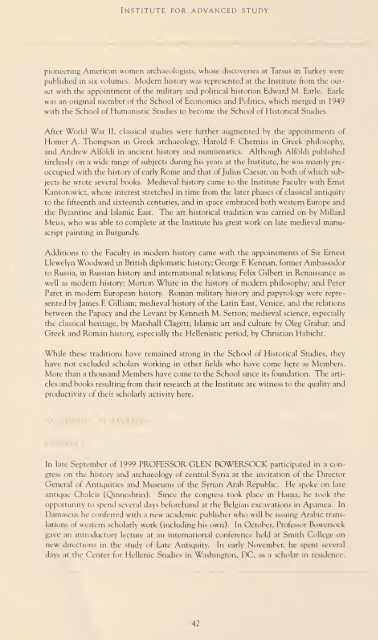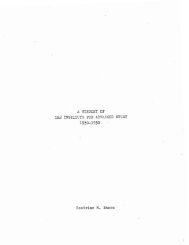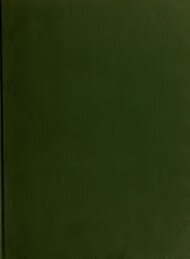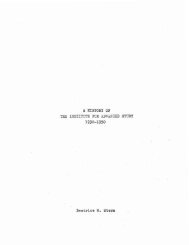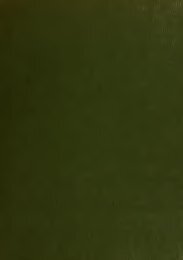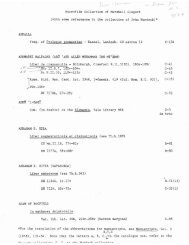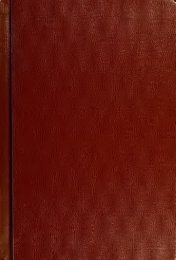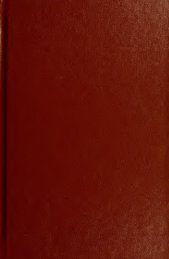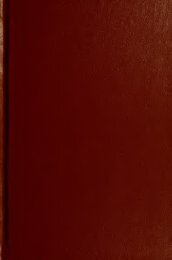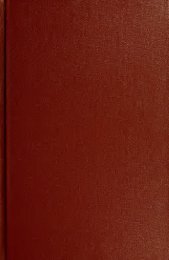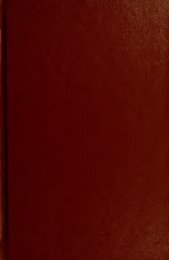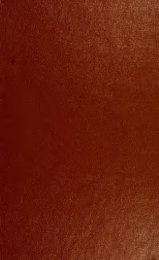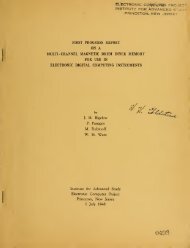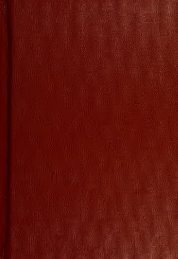Report for the academic year - Libraries - Institute for Advanced Study
Report for the academic year - Libraries - Institute for Advanced Study
Report for the academic year - Libraries - Institute for Advanced Study
Create successful ePaper yourself
Turn your PDF publications into a flip-book with our unique Google optimized e-Paper software.
<strong>Institute</strong> <strong>for</strong> advanced study<br />
pioneering American women archaeologists, whose discoveries at Tarsus in Turkey were<br />
published in six volumes. Modern history was represented at <strong>the</strong> <strong>Institute</strong> from <strong>the</strong> out-<br />
set with <strong>the</strong> appointment of <strong>the</strong> military and political historian Edward M. Earle. Earle<br />
was an original member of <strong>the</strong> School of Economics and Politics, which merged in 1949<br />
with <strong>the</strong> School of Humanistic Studies to become <strong>the</strong> School of Historical Studies.<br />
After World War II, classical studies were fur<strong>the</strong>r augmented by <strong>the</strong> appointments of<br />
Homer A. Thompson in Greek archaeology, Harold F. Cherniss in Greek philosophy,<br />
and Andrew Alfoldi in ancient history and numismatics. Although Alfoldi published<br />
tirelessly on a wide range of subjects during his <strong>year</strong>s at <strong>the</strong> <strong>Institute</strong>, he was mainly pre-<br />
occupied with <strong>the</strong> history of early Rome and that of Julius Caesar, on both of which sub-<br />
jects he wrote several books. Medieval history came to <strong>the</strong> <strong>Institute</strong> Faculty with Ernst<br />
Kantorowicz, whose interest stretched in time from <strong>the</strong> later phases of classical antiquity<br />
to <strong>the</strong> fifteenth and sixteenth centuries, and in space embraced both western Europe and<br />
<strong>the</strong> Byzantine and Islamic East. The art historical tradition was carried on by Millard<br />
Meiss, who was able to complete at <strong>the</strong> <strong>Institute</strong> his great work on late medieval manu-<br />
script painting in Burgundy.<br />
Additions to <strong>the</strong> Faculty in modern history came with <strong>the</strong> appointments of Sir Ernest<br />
Llewelyn Woodward in British diplomatic history; George F. Kennan, <strong>for</strong>mer Ambassador<br />
to Russia, in Russian history and international relations; Felix Gilbert in Renaissance as<br />
well as modern history; Morton White in <strong>the</strong> history of modern philosophy; and Peter<br />
Paret in modern European history. Roman military history and papyrology were repre-<br />
sented by James F. Gilliam; medieval history of <strong>the</strong> Latin East, Venice, and <strong>the</strong> relations<br />
between <strong>the</strong> Papacy and <strong>the</strong> Levant by Kenneth M. Setton; medieval science, especially<br />
<strong>the</strong> classical heritage, by Marshall Clagett; Islamic art and culture by Oleg Grabar; and<br />
Greek and Roman history, especially <strong>the</strong> Hellenistic period, by Christian Habicht.<br />
While <strong>the</strong>se traditions have remained strong in <strong>the</strong> School of Historical Studies, <strong>the</strong>y<br />
have not excluded scholars working in o<strong>the</strong>r fields who have come here as Members.<br />
More than a thousand Members have come to <strong>the</strong> School since its foundation. The arti-<br />
cles and books resulting from <strong>the</strong>ir research at <strong>the</strong> <strong>Institute</strong> are witness to <strong>the</strong> quality and<br />
productivity of <strong>the</strong>ir scholarly activity here.<br />
In late September of 1999 PROFESSOR GLEN BOWERSOCK participated in a con-<br />
gress on <strong>the</strong> history and archaeology of central Syria at <strong>the</strong> invitation of <strong>the</strong> DirectOI<br />
General of Antiquities and Museums of <strong>the</strong> Syrian Arab Republic. He spoke on late<br />
antique Chalcis (Qinneshrin). Since <strong>the</strong> congress took place in Hama, he took <strong>the</strong><br />
opportunity to spend several days be<strong>for</strong>ehand at <strong>the</strong> Belgian excavations in Apamea. In<br />
Damascus he conferred with a new <strong>academic</strong> publisher who will be issuing Arabic trans<br />
lations of western scholarly work (including his own). In October, Professor Bowersock<br />
gave an introductory lecture at an international conference held at Smith College on<br />
new directions in <strong>the</strong> study of Late Antiquity. In early November, he spent several<br />
days at <strong>the</strong> Center tor Hellenic Studies in Washington, DC, as a scholar in residence.<br />
42


